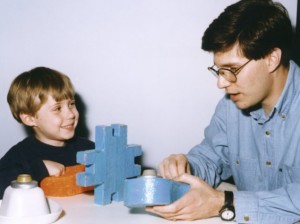Cognitive flexibility plays a role in an important part of children’s language development: learning new words. Children hear many unfamiliar words. These words are moving targets: the cues to their meanings are extremely varied and always changing. Remember, toddlers can’t use dictionaries!
 For example, if a 3-year-old hears that some object is made of aluminum (an unfamiliar word), they should focus attention on material properties (e.g., texture, color). If they then hear that the object has a gauge, they should shift attention from its material to some noticeable part. From 3 to 6 years of age children get better at this flexible use of language cues to learn words. From cue to cue, some 3-year-olds perseverate, inferring the same meaning for successive words, even if the cues change. Others 3-year-olds haphazardly change their inferences about successive words. These odd errors diminish with age: most 4-year-olds flexibly infer different meanings for each word, appropriate to each new cue (though some 4-year-olds still perseverate). Finally, almost all 5- and 6-year-olds reliably adjust their inferences to changing cues.
For example, if a 3-year-old hears that some object is made of aluminum (an unfamiliar word), they should focus attention on material properties (e.g., texture, color). If they then hear that the object has a gauge, they should shift attention from its material to some noticeable part. From 3 to 6 years of age children get better at this flexible use of language cues to learn words. From cue to cue, some 3-year-olds perseverate, inferring the same meaning for successive words, even if the cues change. Others 3-year-olds haphazardly change their inferences about successive words. These odd errors diminish with age: most 4-year-olds flexibly infer different meanings for each word, appropriate to each new cue (though some 4-year-olds still perseverate). Finally, almost all 5- and 6-year-olds reliably adjust their inferences to changing cues.
One study (Deák & Narasimham, 2013) showed that 3- to 5-year-old children show consistent individual difference in flexibility across two FIM tests. However, they are less consistent in a rule-switching flexibility test that is matched with the other tests for difficulty and task demands (Deák & Wiseheart, in review). This suggests that cognitive flexibility is not a generalized cognitive ability, but is task-dependent and tied to an individual’s knowledge and skills.
Return to Cognitive Control page